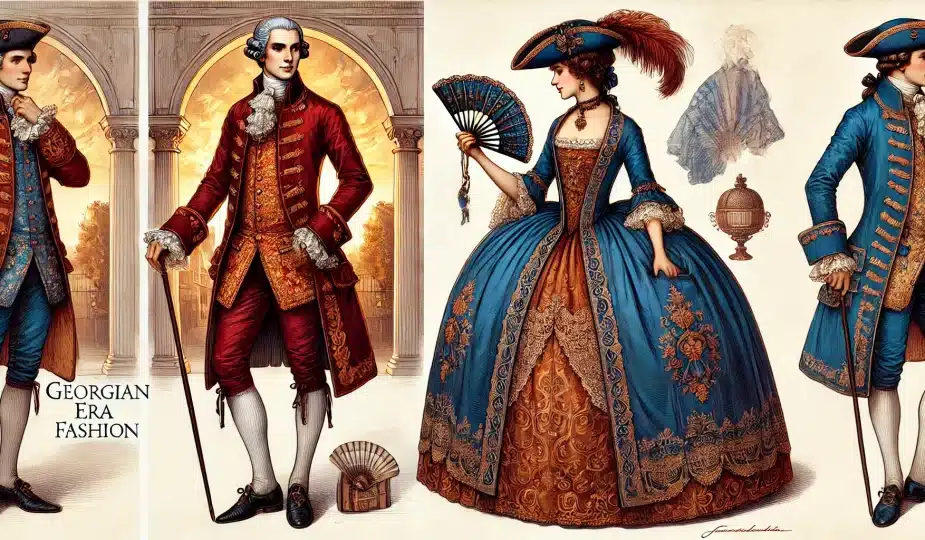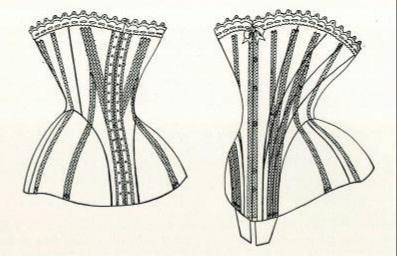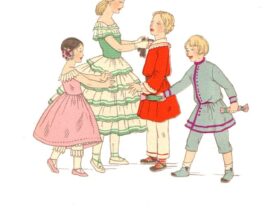The 18th century marked a time of opulence and refinement in fashion, where the clothing worn by society’s elite was not only a display of wealth but also an intricate work of art. Lavish brocade, shimmering silks, and meticulously crafted accessories adorned the upper classes, while more modest materials such as wool and linen dressed the working class.
From the long, buttoned coats of the Justaucorps to the slim-fitting breeches of the mid-century, Georgian-era fashion was both functional and decorative, reflecting the social and cultural changes of the time. This guide delves into the rich details of men's fashion during the 1700s, exploring everything from the labor-intensive waistcoats to the iconic cravats and accessories that completed the look.
Georgian Era Fashion: 1714-1837
The Georgian Era spans the reigns of England's George I through George IV. At the start of the century, both men and women of the upper classes wore ornate, elaborate clothing. By the mid-1700s, garments were often adorned with 3D textural elements like bows, ribbons, and gold trims, which added layers of complexity.
Footwear for both men and women typically featured pointed toes and square buckles, solidifying the overall aesthetic of refined elegance.
1700s Men's Fashion: The Essentials
Men typically wore a suit consisting of a shirt, waistcoat (vest), coat, and breeches with stockings. The cut of the coat and waistcoat did change somewhat throughout the century; however, the distinctive coat of the 1700s had large cuffs with buttons, while the front of the coat had many buttons going down the front.
Men’s shirts
Men’s shirts were usually long and made of a whole width of thin linen fabric, with a collar and ruffles around the sleeve and neckline. The sleeves were quite wide, then brought in by a band at the wrist. Below the band, an inch or two of fabric poked out, creating a ruffle that would stick out below the cuff of a coat sleeve.
Shirts were versatile: at this time, people didn’t own many items of clothing as this was before the invention of the sewing machine, so all garments were stitched by hand. Shirts were worn tucked in, and were easier to wash than vests or coats.
Men would wear their shirts as night clothes as they were long. As the shirt fabric was quite thin, men typically did not wear shirts without vests (also called waistcoats) in public unless he was conducting physical labor. It would be similar to a man wearing no shirt today.
Breeches in the 1700s
Breeches were short pants that in the 1700s, ended below the knee. In earlier centuries, the breeches were shorter and rounder. In the 1700s, there was a band below the knee with a closure of either a buckle or buttons.
Breeches of the mid-1700s had a front fall waistband - instead of a zippered fly like modern trousers, there was a button on each side at the front to button and unbutton the breeches. There were button-fly breeches as well.
Breeches generally had a slim fit through the thighs. At the back waistband, an opening with eyelets laced up the waistband, providing a better fit. Sometimes there could be a small pocket at the front.
Vests and Waistcoats of the 1700s
Vests were an important part of a men’s wardrobe in the 1700s. Fabric for waistcoats could be made of wool, cotton, linen, or silk if he could afford it.
While working-class men would wear plainer waistcoats, those of greater means would wear vests of fine fabric and ornamentation. Floral embroidery was a popular choice. The fabric could be plain or of a woven brocade fabric for more ornamentation.
Waistcoats were quite long in the early part of the century and gradually became shorter. The buttons on waistcoats were often covered in matching fabric. Buttonholes were fairly close together, and a waistcoat could have easily more than a dozen buttons. Sewing buttonholes by hand is a time-consuming process, meaning that quite a lot of labor went into making a waistcoat.
Despite being long and with many buttons, waistcoats had a curved shape, which meant that the buttons at the top near the neck and below the waistline didn’t usually meet to button up. Waistcoats often had pockets on the front left and right sides with a shaped flap.
Georgian Era Men’s Coats
Men’s coats in the 1700s were made of two main styles: the Justaucorps at the beginning of the century, and the frock coat around the middle of the century.
Justaucorps
The Justaucorps was quite long, with many buttons and buttoning all the way down. This style of coat replaced the earlier doublet jacket and started to appear around the late 1660s. It was worn into the 1700s.
Frock Coat
One of the main differences between the frock coat and the Justaucorps is that the frock coat does not button all the way down. It is curved and only buttons in the middle, if at all. While wearing a frock coat, the waistcoat can be seen.
Both styles of coats typically feature a skirt at the back, with the fabric hanging in pleats. There would be a slit in the back, with one button on each side.
Long Aprons
Aprons are worn long and have good pockets. Cuffs are deep but are lowered to below the elbow. The bodice of the gown is cut high in the back and low in front, and is decked with a deep frill of lace or linen, which allows less bare neck to show than formerly.
1700s Women's Fashions
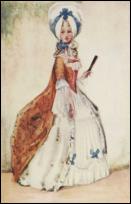
Women’s fashion in the 1700s was equally elaborate, characterized by wide skirts, fitted bodices, and intricate detailing.
The color plate on the left shows the last of the pannier dresses, which gave way in 1794 or 1795 to Empire dresses. We have another article about Georgian Era women's hair.
Pannier Dresses
At the height of the century, women wore panniers—a framework worn under gowns to extend the width of skirts dramatically at the sides, giving the silhouette an exaggerated, grand appearance.
Then we have the plate on the right shows the Polonaise skirt from 1775. After the French Revolution, all dress of both men and women underwent radical changes.

Polonaise Skirts
Later in the century, skirts became less extreme, giving way to the Polonaise style, which involved the outer skirts being looped or bunched up to reveal the decorative petticoat underneath.
Empire Dresses
By the end of the 1700s, following the French Revolution, women’s fashion saw a radical change, with the arrival of Empire dresses. These gowns featured high waistlines just below the bust, with flowing, lightweight fabrics, in stark contrast to the structured styles of the earlier century.
Queen Anne Fashion – 1702-1714
Queen Anne was born in 1665. Married to Prince George of Denmark in 1683, reigned for 12 years from 1702 to 1714.
During Queen Anne’s reign, women's skirts became incredibly wide with enormous hooped petticoats. The bodice of gowns was cut high in the back and low in front, often adorned with lace or frills. This period also saw deep cuffs and long aprons with practical pockets.
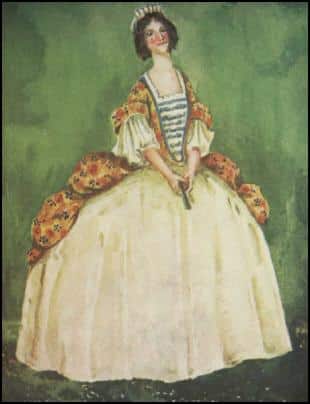
Notice that the frontage has become much lower, and the hoop of the skirt has become enormous. The hair is more naturally dressed.
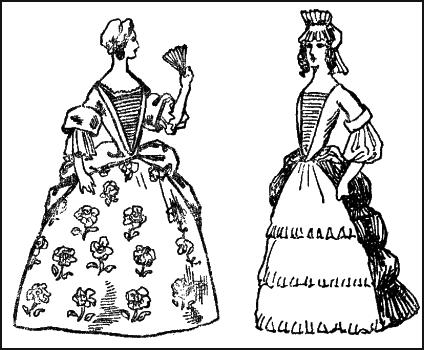
Georgian Era Men and Women’s Accessories
Footwear
Footwear for both men and women at this time were typically black leather shoes with a single square buckle on the front. The toes were also square.
Hair
Men’s hair was often shoulder length, tied back with a ribbon in a bow. Wigs were also popular in the latter part of the 1800s for the upper classes, with curls and long hair tied in a bow.
Tricorne Hat
Tricorne hats were wide brimmed hats tacked up in three places to create a triangular-shaped brim. Often adorned with a gold braid around the edge, and sometimes with a large feather.
Neckwear
Men’s neckties have changed throughout history. In the Georgian era, a cravat was a long rectangle of thin cloth wrapped around the neck, typically tied at the front in a knot starting mid-century.
In the 1700s, cravats were almost always white linen.
The Ramillies White Wig
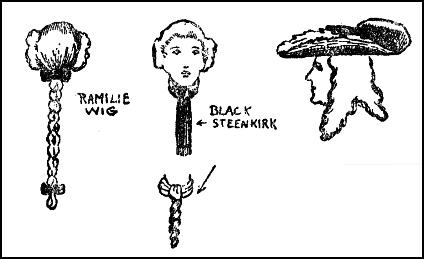
In the latter part of the 1700s, wigs became an essential accessory for the upper classes. Men wore powdered wigs in various styles, from the shoulder-length, tied-back queues to the elaborate Ramillies wig described in English Costume, where white hair was gathered into a long queue at the back and adorned with black ribbons. These wigs were powdered and often perfumed, symbolizing wealth and status.
Gentleman’s Cane
A gentleman’s cane was another important accessory, often featuring intricate designs with curiously clouded amber heads or silver gilt buttons, as detailed in English Costume. The cane was not just a walking aid, but a symbol of elegance. It was frequently used for dramatic gestures—such as summoning a coachman or pointing out someone of interest. Often adorned with ribbons, the cane was a highly fashionable item that signified a gentleman's refinement and attention to detail.
Fans and Stomachers for Women
Women carried fans as a fashionable accessory, and their bodices were often decorated with stomachers—ornate, triangular panels that extended the bodice and added decorative flair.
Fashion of the Georgian Era
Fashion in the Georgian Era was not only a marker of personal style but also a symbol of social status. Every element, from the finely stitched ruffles on shirts to the square-toed, buckle-adorned shoes, showcased the artistry and time invested in each garment.
The accessories, from cravats to tricorne hats and fans to ornate hairpieces, added the finishing touches that signaled wealth and sophistication. Whether made of simple wool or luxurious silk, every piece of clothing in this era told a story of elegance, practicality, and the ever-present desire to display one’s place in society.
